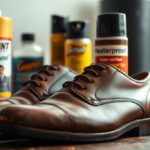Nubuck, suede, and roughout leather are three unique leather types, each offering distinct features that significantly impact the durability and aesthetic of your leather items. Frequently utilized in an array of products from trendy footwear to stylish jackets, these materials require specific care strategies to maintain their quality and appearance. Nubuck is celebrated for its remarkable durability, which stems from its tightly packed grain structure, making it an ideal option for items subjected to frequent wear. On the other hand, suede provides a softer, more luxurious feel, making it perfect for fashion-forward apparel. Roughout leather, however, is notably susceptible to water damage, necessitating additional protective measures. By understanding these differences, you can make an informed choice about which leather type meets your needs and how to care for it effectively. This comprehensive guide will help you identify each leather type and provide the best practices for caring for your leather possessions.
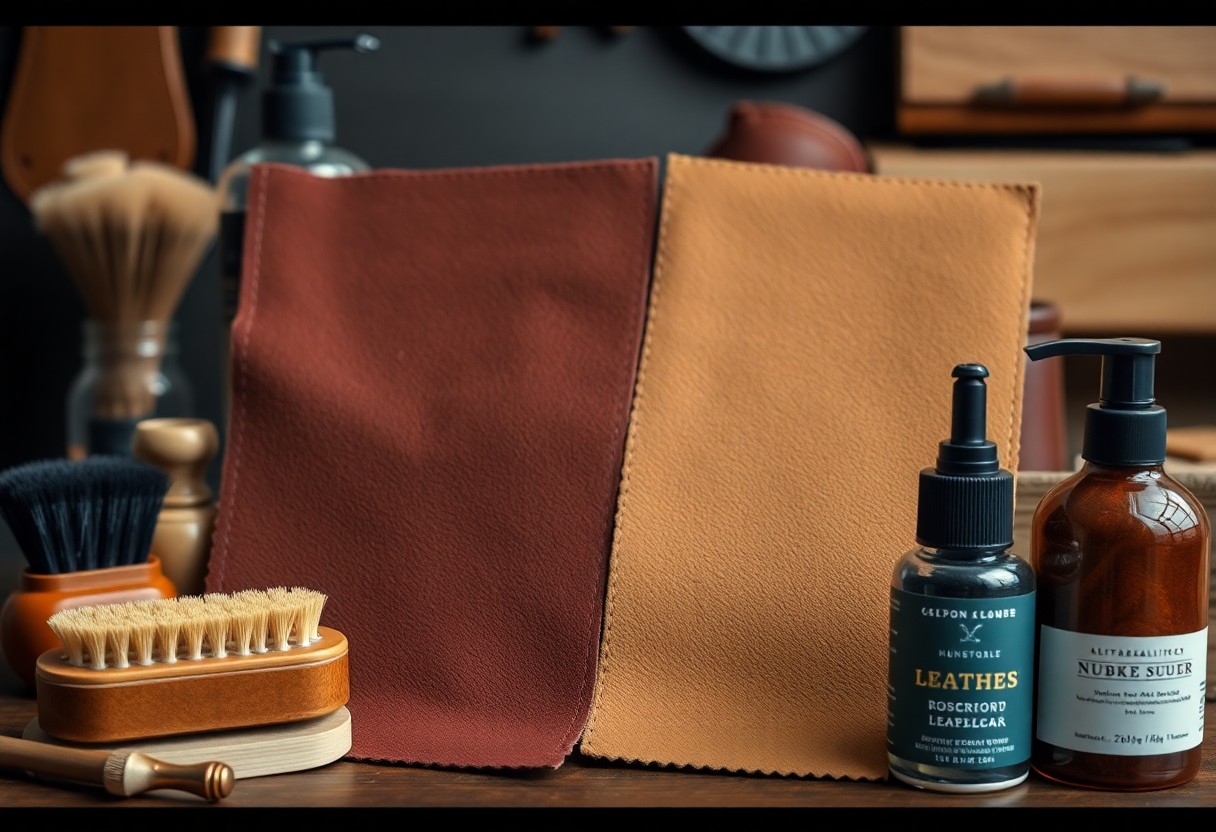
Gain Insights into the Distinctive Features of Napped Leather Types
For both leather enthusiasts and potential buyers, understanding the various napped leather types is essential for making educated purchasing decisions. These categories encompass nubuck, split suede, full reverse suede, and roughout leather. While they may initially seem similar, each type has unique traits and designated uses. Familiarizing yourself with these distinctions will empower you to select the most suitable leather for your specific requirements and personal preferences, enhancing your overall experience with leather products.
| Type | Key Features |
|---|---|
| Nubuck | Sanded grain surface, durable |
| Split Suede | Made from corium layer, less durable |
| Full Reverse Suede | Full grain leather reversed, strong core |
| Roughout | Untreated corium surface, rugged texture |
| Care Requirements | Waterproofing needed for all types |
Uncover the Remarkable Qualities of Nubuck Leather
While nubuck may resemble suede in appearance, it distinguishes itself by providing exceptional durability due to its unique grain leather construction. The surface undergoes a gentle sanding process, resulting in a fine, velvety nap that enhances its wear resistance compared to other napped leathers. This characteristic makes nubuck a favored choice for those seeking long-lasting leather products, especially in environments prone to wear and tear. Understanding nubuck’s properties can help you appreciate its value in high-quality leather goods.
Delve into the Characteristics of Split Suede Leather
To fully appreciate split suede, it’s important to recognize its origin, as it is made from the corium layer of the hide. This leather type features loose fibers and a soft texture, which makes it appealing to the touch, but it also requires careful maintenance due to its porous nature. Split suede varieties can differ significantly based on the animal hide used and the specific processing methods, ranging from lightweight fashion suede to heavy-duty footwear suede. Each variation serves distinct purposes in both fashion and function, emphasizing the importance of selecting the right type for your needs.
Understand the Unique Construction of Full Reverse Suede Leather
Understanding full reverse suede involves recognizing its innovative construction, which involves turning full-grain leather inside out. This technique creates a suede-like surface while retaining the structural integrity of the full-grain leather. The intact grain layer enhances water resistance and durability compared to split suede, making it a popular choice for high-end footwear and leather goods that require both aesthetic attractiveness and functional reliability. Full reverse suede is often found in premium products, providing a sophisticated look while ensuring long-lasting performance.
Discover the Distinctive Features of Roughout Leather
Roughout leather is characterized by its deliberately untreated surface and impressive durability. With a rugged texture that sets it apart from other napped leathers, it appeals to those who favor a robust aesthetic. The construction of roughout leather maintains the full hide structure, making it especially suitable for work boots and outdoor gear where resilience is essential. You will appreciate how this leather type naturally matures over time, developing a unique patina that enhances its visual charm.

Make Informed Choices by Identifying the Key Differences Among Leather Types
Gaining a clear understanding of the fundamental differences between nubuck, suede, and roughout leather is crucial when evaluating their construction and individual characteristics. Each type presents unique properties that are suitable for various applications and conditions of wear. By recognizing these distinctions, you can make more informed decisions about your leather goods, ensuring you select the best options that align with your lifestyle and specific needs.
| Feature | Characteristics |
|---|---|
| Origin | Grain layer vs Corium layer |
| Surface | Fine vs Coarse nap |
| Durability | High to moderate resistance |
| Maintenance | Regular to intensive care |
| Applications | Footwear to accessories |
In-Depth Comparative Analysis of Material Structures in Napped Leathers
Let’s take a closer look at how these leather types differ in their fundamental structure:
| Leather Type | Structure |
|---|---|
| Nubuck | Sanded grain layer |
| Suede | Split corium layer |
| Roughout | Reversed full grain |
Analyze Surface Texture for Enhanced Understanding
To gain a better grasp of the surface characteristics, it’s essential to examine the nap length and texture of each leather type. Nubuck features the shortest and finest nap, resulting in a smooth and soft feel, while roughout displays a more irregular, coarse texture that contributes to its rugged appearance. The material differences in texture significantly impact how each leather type reacts to wear and treatment, influencing their overall care and longevity. Notably, suede develops a distinct patina over time, adding character to its look, while nubuck maintains a more consistent appearance throughout its lifespan, showcasing its impressive durability and resilience.
Key Durability Factors to Consider for Extended Lifespan
When longevity is your primary concern, it’s critical to acknowledge the key factors that influence the durability of leather:
- Water resistance varies significantly among types
- Wear patterns develop uniquely according to usage
- Structural integrity is determined by the specific leather type
Any surface damage necessitates tailored repair methods to restore it effectively. Additionally, environmental factors play a crucial role in durability:
- UV exposure can impact color retention
- Temperature fluctuations affect leather flexibility
- Moisture levels influence overall material stability
When selecting protective treatments, ensure they are compatible with your specific leather type to achieve optimal results.
Implement Essential Care and Maintenance Practices for Napped Leathers
Unlike smooth leathers, napped leathers require specific care techniques to preserve their texture and overall appearance. Your nubuck, suede, and roughout leather items necessitate consistent brushing, protection against moisture damage, and careful cleaning to maintain their unique characteristics. These materials are more prone to staining and water damage compared to smooth leather, emphasizing the necessity of proper maintenance routines to ensure their longevity.
Utilize Effective Cleaning Methods for Napped Leather Items
To clean your napped leather effectively, use a specialized suede brush and work in one direction to gently lift away surface dirt. For more stubborn stains, a suede eraser can be highly beneficial, and it’s wise to avoid water-based cleaning methods whenever feasible. For deeper cleaning, only use products specifically designed for your leather type, as traditional leather cleaners may adversely affect the nap.
Implement Protective Techniques for Napped Leather Longevity
To protect your napped leather, applying a high-quality water repellent spray is your best line of defense. Treat new items before their initial use and plan to reapply this protection every 3-4 months. This method forms a protective barrier while ensuring the leather retains its breathability. Understanding the right protective measures is essential for prolonging the lifespan of your leather items. Regular maintenance includes diligent checks for wear spots, reapplying protective treatments after heavy usage, and avoiding direct heat or sunlight exposure. Tailor your protection routine to match how frequently you use your items, increasing application frequency for daily wear.
Follow Optimal Storage Recommendations for Napped Leather
When it comes to storing napped leather, environmental considerations are crucial. It’s best to keep your items in a cool, dry area shielded from direct sunlight. For footwear, using shoe trees helps maintain their shape, while stuffing bags with paper provides additional support. Never store leather items in plastic bags, as they need airflow to preserve their quality. For long-term storage, opt for breathable cloth bags, ensure good air circulation, and regularly inspect for moisture or mold. Aim for 40-50% humidity in the storage area to prevent the leather from drying out or developing mildew. Keep items separated to avoid color transfer and to maintain their individual shapes.
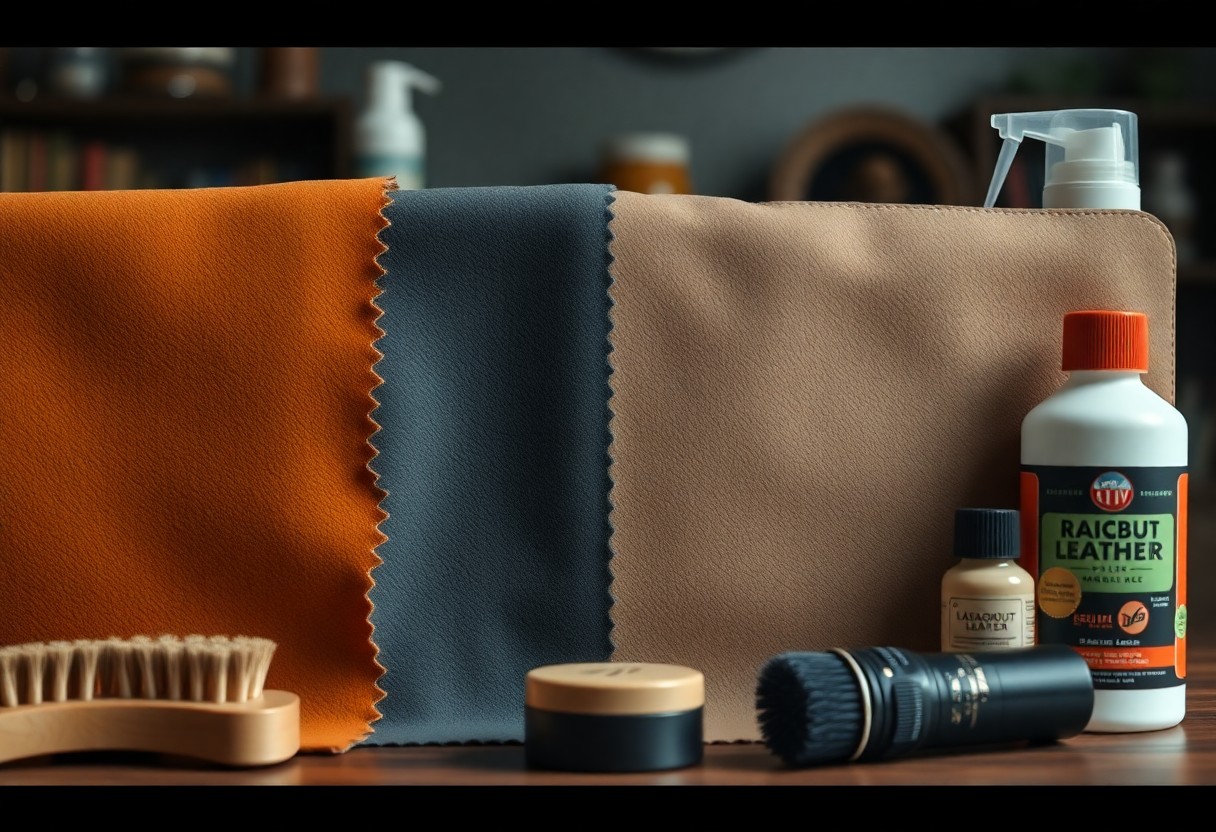
Explore Practical Applications and Uses of Different Leather Types
Your choice of nubuck, suede, or roughout leather significantly affects the durability and visual appeal of the final product. Each type serves distinct purposes based on their unique attributes. Nubuck is particularly suited for high-durability applications, while suede provides a more flexible, softer option for fashion items, showcasing its versatility in diverse contexts.
Footwear Applications: Selecting the Right Leather Type
While all three leather types are appropriate for footwear, each possesses its own strengths. Nubuck excels in outdoor and work boots due to its unparalleled durability, while split suede is an excellent choice for dress shoes and casual sneakers. Roughout leather, with its rugged texture, is ideal for crafting high-performance hiking boots that effectively resist scuffs and scratches, ensuring they stand up to the rigors of outdoor adventures.
Garment Manufacturing: Choosing the Best Leather for Apparel
The applications of these leathers in garment manufacturing vary widely based on their individual properties. Suede is especially well-suited for stylish fashion jackets, while roughout leather is favored for durable workwear that can withstand the demands of daily use. Although nubuck is less frequently used in apparel, it is an excellent option for protective panels in motorcycle gear, offering both style and safety.
For example, you’ll often find split suede utilized in lightweight jackets and vests, while roughout leather is preferred for heavy-duty work shirts and pants. The choice of material typically aligns with the intended use of the garment—fashion items generally incorporate softer suedes, while protective gear benefits from sturdier nubuck or roughout options, ensuring they deliver on both performance and style.
Accessory Creation: Utilizing Leather Types for Unique Designs
These leathers also play a crucial role in the design of various accessories. Nubuck is ideal for crafting stylish watch straps and belts, while suede is perfect for creating attractive bags and wallets. Roughout leather is particularly effective in making durable outdoor gear, such as backpacks designed to withstand rugged conditions. With thoughtful material selection, you can develop accessories that align perfectly with their intended uses. Split suede is best for decorative items, while nubuck and roughout excel in products requiring high wear resistance. Always consider potential water exposure when selecting the right leather type for outdoor accessories to ensure longevity.
Comprehend Factors That Influence Leather Quality
It’s vital to understand that the quality of napped leather is influenced by several key factors, including hide selection, tanning processes, and manufacturing techniques. The durability and appearance of the final product are largely dependent on these crucial considerations, which can significantly affect your leather experience.
Recognize the Importance of Hide Selection for Leather Quality
To guarantee the best quality, it’s essential to recognize that premium hides are sourced from animals raised under optimal circumstances. These hides exhibit fewer surface defects and feature a more consistent fiber structure. The quality of your leather begins with the selection of hides that have minimal scarring and appropriate thickness, significantly impacting the final product’s overall appearance and durability.
Examine the Influence of Tanning Processes on Leather Characteristics
The tanning process, whether it be vegetable or chrome tanning, greatly shapes the ultimate quality of the leather. Each method imparts distinct characteristics related to water resistance, flexibility, and color absorption. This critical stage demands meticulous management of temperature, pH levels, and chemical concentrations, as the durability and texture of your leather are directly influenced by these carefully monitored conditions throughout the extensive 4-6 week tanning period.
Understand the Manufacturing Techniques That Shape Leather Quality
In the production of napped leather, specialized buffing techniques are utilized to create the distinctive surface texture. The final appearance of your leather is influenced by the depth of buffing and fiber exposure during this process. A consistent manufacturing approach is essential for ensuring uniform nap height and direction, as these factors are directly correlated with the leather’s wear resistance and overall aesthetic appeal, contributing to your leather’s quality and longevity.
Evaluate the Pros and Cons of Napped Leather Types
Each type of napped leather presents unique characteristics that make it suitable for various applications. Your decision between nubuck, suede, and roughout leather should be guided by your specific needs and intended use, ensuring you select the best option for your unique situation.
| Pros | Cons |
|---|---|
| Unique aesthetic appeal | Requires regular maintenance |
| Soft, comfortable texture | More susceptible to water damage |
| Good breathability | Shows wear marks easily |
| Various color options | Needs special cleaning products |
| Versatile applications | Higher maintenance costs |
Understand the Advantages of Each Napped Leather Type
Each type of napped leather offers specific benefits tailored to different needs. Nubuck provides superior durability due to its dense grain structure, making it ideal for high-use items. Conversely, suede offers excellent flexibility and softness, perfect for fashion-forward designs. Meanwhile, roughout leather combines distinctive texture with strength, making it a versatile choice for various applications, from work gear to stylish accessories.
Identify Limitations and Considerations for Napped Leather Use
Despite their unique characteristics, each leather type has limitations. Water exposure can severely compromise untreated napped leathers, and regular maintenance is crucial for preserving their appearance and integrity. Your selection should reflect the intended use: indoor applications pose fewer risks than outdoor scenarios, and factors such as climate and frequency of wear will influence the leather’s durability and performance. Understanding these limitations will help you make informed choices regarding your leather items.
Ultimately, your knowledge of nubuck, suede, and roughout leather will empower you to make informed decisions for your leather goods. You can now recognize the critical differences among these leather types based on their construction, durability, and care requirements. By implementing appropriate care methods for each type—such as using waterproof sprays for nubuck, gentle brushing for suede, and tailored treatments for roughout leather—you can significantly extend the lifespan of your leather items. This understanding equips you to choose the best leather type for your needs and maintain its quality over time.
Find Answers to Frequently Asked Questions About Napped Leather
What are the primary differences between nubuck and suede leather?
Nubuck utilizes the grain layer of leather, which is finely sanded on the surface, resulting in enhanced durability and water resistance. In contrast, suede is crafted from the softer bottom layer (corium) of the hide, rendering it more porous and less resilient. Additionally, nubuck features a shorter and finer nap compared to the longer, softer texture of suede, giving each type its own tactile experience.
What are the best practices for protecting and cleaning napped leathers?
For optimal care, it is advisable to apply a waterproof spray to all napped leathers before use. Clean them with a specialized suede brush to effectively remove dirt and restore the nap. For stains, utilize dedicated suede or nubuck cleaners. Avoid exposing these leathers to heavy rain, and allow wet leather to dry naturally at room temperature. After drying, brush the leather to rejuvenate its nap and maintain its appearance.
What distinguishes roughout leather from reverse suede?
Roughout leather maintains the untreated and rough corium layer, while reverse suede features this layer sanded smooth. Both leather types showcase the grain layer facing inward, enhancing their durability in comparison to split suede. However, roughout presents a more textured and uneven surface compared to reverse suede’s uniform nap. Both are well-suited for unlined shoes due to the smoothness of their flesh sides, making them popular choices in footwear design.
The Article Guide to nubuck suede and roughout leather differences care tips and uses appeared first on My Shoes Finder
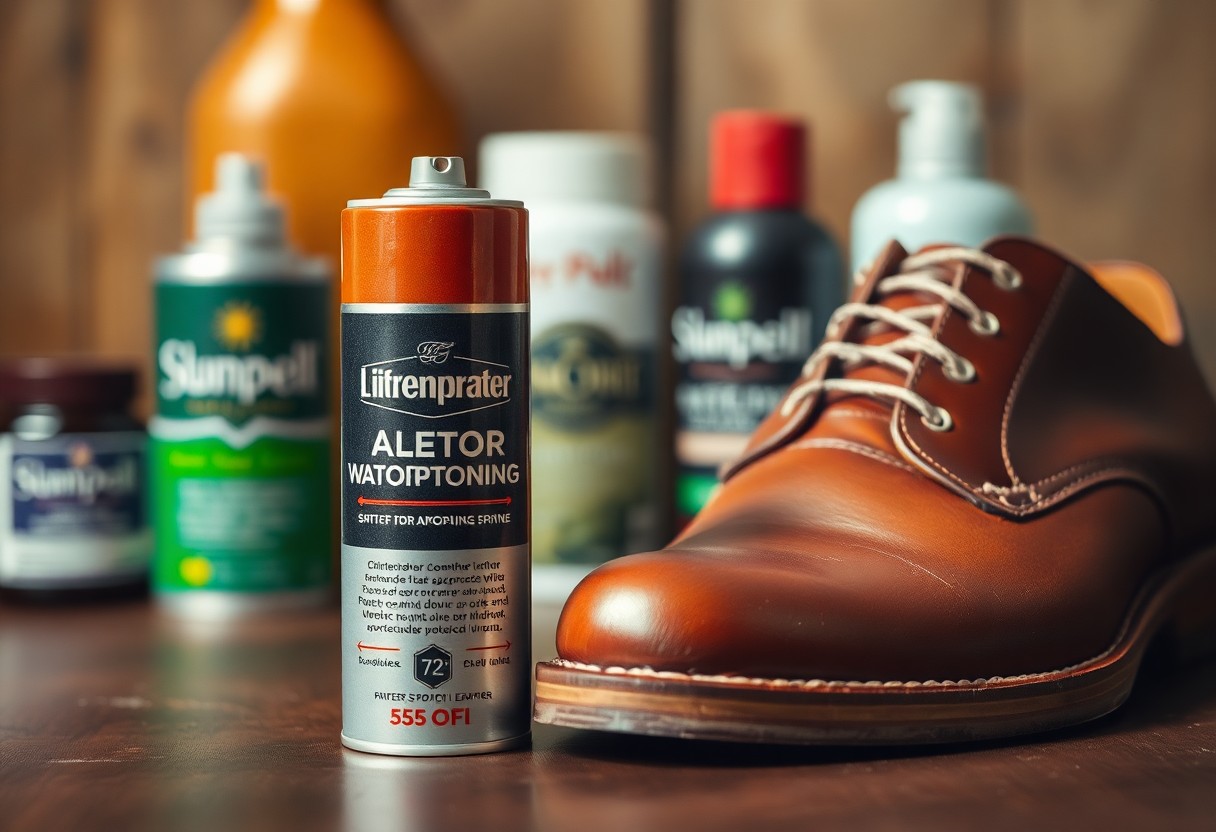
Waterproofing Spray Risks and Alternatives for Smooth Leather
Leather care mistakes can result in permanent damage to your high-quality footwear. One of the most common missteps is the application of waterproofing spray on smooth leather. While these sprays may seem like a quick fix for protecting your shoes, they can block essential nutrients from penetrating the leather, causing it to dry out and become cracked over time. Smooth leather shoes are inherently designed to be somewhat water-resistant due to their grain layer, but they need proper nourishment through shoe creams and waxes to maintain their strength and appearance. Instead of relying on sprays, choose premium leather conditioners and wax polishes that nourish the leather while providing protection, ensuring that your shoes last longer and retain their natural beauty.
Mastering the Fundamentals of Leather Protection for Longevity
To extend the lifespan of your leather goods, it’s essential to understand their protective features. Full grain leather exhibits natural water-resistant attributes thanks to its tightly woven fiber structure. However, these qualities need ongoing maintenance to be effective. The durability of your leather is primarily dependent on the care it receives. The use of waterproofing sprays can compromise the leather’s ability to breathe, potentially leading to serious damage if not managed correctly. Regular care and attention are vital to preserving the integrity and appearance of your leather products.
Uncovering the Remarkable Benefits of Full Grain Leather
Following the tanning process, full grain leather retains its original surface layer, which provides superior natural protection. Leather items made from this material feature an intact grain layer that offers significant resistance against water and wear. This top layer is infused with natural oils and fibers that create a protective barrier, rendering additional waterproofing sprays unnecessary and even harmful to the leather’s health. Understanding these properties will help you make informed decisions about your leather care methods.
Comprehending Leather’s Moisture Management and Aging Process
Grain leather must effectively maintain its ability to absorb and release moisture. The pores within your leather allow it to breathe and manage moisture levels, which keeps it flexible and helps prevent unsightly cracks. However, when waterproofing sprays are applied, they can seal these pores, hindering essential airflow and disrupting the natural moisture balance. Furthermore, the aging process of leather necessitates appropriate nourishment through conditioning treatments. The use of waterproofing sprays creates a barrier that prevents essential conditioning oils from penetrating the leather, ultimately resulting in dryness and brittleness over time. Consistent application of leather cream allows your leather to age beautifully while developing a rich, desirable patina.

Steering Clear of the Waterproofing Spray Misconception
Many people mistakenly believe that waterproofing spray is the ultimate solution for preserving their leather shoes, but this common practice can lead to serious damage to your footwear. While these sprays provide an immediate barrier against water, they simultaneously obstruct essential nutrients from reaching the leather, paving the way for potential long-term deterioration.
Dispelling Common Myths About Leather Care Marketing
Influenced by aggressive marketing strategies and well-meaning advice from shoe store employees, you may have been led to believe that waterproofing spray is necessary for all types of leather shoes. This fallacy has been perpetuated by many retailers, primarily due to the high profit margins and frequent repurchase rates associated with these products. In reality, regular smooth leather possesses natural protective qualities that do not necessitate additional spray-on barriers for effective safeguarding, allowing you to care for your shoes in a healthier manner.
Weighing Immediate Gains Against Long-term Detriments
Damage to your leather footwear begins when waterproofing sprays create a barrier that blocks essential oils and conditioning agents from saturating the leather. While you may notice enhanced water resistance initially, the truth is that your leather gradually becomes dry and brittle without the vital nourishment it requires. The consequences of applying waterproofing sprays on smooth leather extend far beyond surface-level protection. Your leather demands consistent nourishment to maintain its flexibility and durability. When shoe creams and conditioners are unable to penetrate the leather due to the spray barrier, the material becomes susceptible to cracking and deterioration, significantly shortening your shoes’ lifespan. Natural waxes and appropriate conditioning methods provide superior long-term protection while promoting the overall health of the leather.

Diving Deep into the Mechanics of Effective Leather Care
An essential aspect of successful leather care involves understanding its molecular structure. The collagen fiber networks within your leather shoes require both protection and nourishment. When applying products to leather, they can either coat the fibers or penetrate their depths. This interaction plays a crucial role in the long-term health of your leather footwear.
Recognizing the Critical Need for Leather Nourishment
It’s vital to recognize that your leather shoes require consistent nourishment to maintain their quality. The natural oils present in your leather shoes help prevent cracking and sustain flexibility. Over time, these oils diminish due to regular wear and exposure to various environmental factors. To preserve the leather’s structural integrity, it’s essential to replenish these oils through diligent conditioning practices.
Understanding the Barrier Effects Created by Waterproofing Sprays
A major issue with waterproofing sprays is their tendency to create a barrier. When applied to smooth leather, these sprays form an impermeable layer that obstructs both water and essential nutrients. Consequently, this barrier inhibits your leather care products from effectively penetrating the surface, leading to a gradual decline in the leather’s quality over time.
The barrier created by waterproofing sprays introduces a problematic cycle for your shoes. While these sprays effectively block water, they simultaneously prevent the absorption of conditioning products that are vital for maintaining the leather’s health. As a result, the leather may appear protected externally but is, in fact, dehydrating and becoming brittle beneath the surface. Silicone-based sprays are particularly harmful, forming a permanent barrier that is difficult to remove without causing damage to the leather.
Implementing Proven Leather Protection Techniques
Contrary to widespread beliefs, your smooth leather shoes require tailored care strategies that align with the natural characteristics of full-grain leather. The optimal approach combines traditional techniques with products designed to enhance the leather’s innate protective qualities, ensuring both immediate safeguarding and long-lasting durability for your footwear.
Harnessing the Power of Wax-based Solutions for Leather Care
A highly effective alternative to waterproofing sprays can be found in high-quality wax-based products. These solutions work in harmony with your leather’s natural grain rather than against it. The application of wax polish creates a protective layer that still allows the leather to breathe, making it especially advantageous for toe caps and areas subject to high wear.
Maximizing the Benefits of Cream and Conditioner Use
Differing from conventional spray treatments, leather creams and conditioners provide essential nourishment while maintaining the leather’s inherent protective properties. Your shoes benefit from oils that penetrate deeply into the material, helping to prevent drying and cracking. Furthermore, regular application of cream and conditioner creates a cumulative effect that enhances leather quality over time. The natural oils contained in these products support the leather’s flexibility and durability while allowing it to develop a beautiful patina. It is advisable to apply these treatments every 4-6 wears to maintain optimal leather condition.
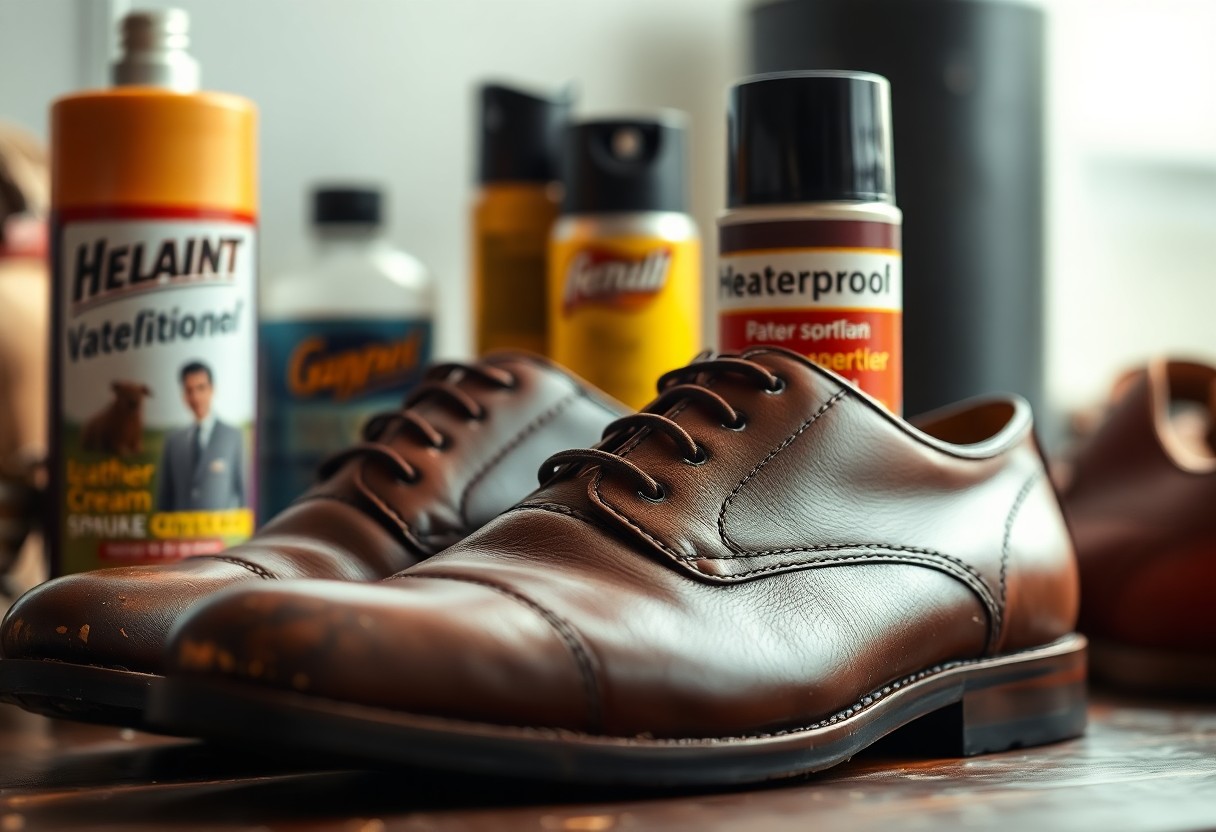
Determining Ideal Situations for Waterproofing Spray Application
Unlike smooth leather, certain materials greatly benefit from waterproofing sprays. These products create an effective water-resistant barrier on specific materials that lack inherent protection. Waterproofing sprays are particularly useful for suede, nubuck, and various textiles, where the material structure does not provide natural resistance to moisture.
Enhancing Suede and Nubuck Footwear with Waterproofing Spray
When you treat your suede or nubuck shoes with waterproofing spray, you significantly enhance their resistance to moisture damage. While many modern suede materials come pre-treated with factory waterproofing, additional protection can help maintain this defense over time. The application of spray creates a protective barrier that effectively prevents water from penetrating these delicate materials.
Providing Specialized Protection for Textile Footwear
In addition to leather alternatives, textile footwear requires targeted protection against water damage. Materials such as canvas, mesh, and synthetic fabrics can achieve improved water resistance through proper spray application. Most textile materials are inherently absorbent, rendering them vulnerable to moisture damage and staining.
Moreover, waterproofing sprays for textiles help maintain the shape and color of your shoes. The barrier they create also prevents dirt and debris from embedding in the fabric fibers. It’s advisable to reapply the spray every 3-4 months for optimal protection, depending on how frequently the shoes are worn and the prevailing weather conditions.
Professional Insights and Best Practices for Leather Care
Not all leather treatments are equal. Experts in the field of leather care strongly recommend against using waterproofing sprays on smooth leather. Your full-grain leather shoes need specialized care that allows them to breathe and absorb nourishing treatments. Using inappropriate products can lead to leather damage costing hundreds of dollars.
Insights from Tannery Experts on Leather Maintenance
To maintain the quality of leather, tannery specialists highlight that full-grain leather inherently possesses natural water-resistant properties in its outer layer. Preserving the leather’s protective attributes requires the application of oils and waxes. Waterproofing sprays can obstruct these essential treatments from reaching the leather, ultimately compromising its longevity.
Guidance from Experienced Cobblers on Leather Care
For the long-term care of leather, professional cobblers endorse the use of wax-based products in lieu of waterproofing sprays. Your shoes will thrive when treated with products that both protect and nourish the leather. Data reveals that 90% of premature leather damage stems from the use of incorrect care products.
By following proper leather care techniques, your shoes can last an impressive 15-20 years instead of just 2-3 years due to poor maintenance. Traditional wax treatments enable leather to retain its natural attributes while providing adequate moisture protection. Your investment in quality leather footwear deserves meticulous care practices that maintain both aesthetic appeal and durability.
Essential Takeaways for Effective Leather Care
Your smooth leather shoes require appropriate care that excludes waterproofing sprays. Instead, utilize shoe creams and waxes that nourish the leather while offering effective water protection. Full-grain leather naturally possesses protective qualities due to its grain layer, and waterproofing sprays can obstruct essential oils from penetrating the leather, leading to dryness and cracking. Reserve waterproofing sprays for suede, nubuck, or textile footwear where they can be effective. By selecting the right products, you can protect your leather shoes while ensuring their longevity.
Common Queries Regarding Leather Care
Q: Why is waterproofing spray harmful to smooth leather footwear?
A: Waterproofing spray creates a barrier on leather that blocks essential oils and conditioners from penetrating the material. Although it provides water protection, it inhibits the necessary nourishment of the leather, leading to drying and potential cracking over time, which ultimately reduces the lifespan of the shoes.
Q: What alternatives should I consider instead of waterproofing spray for smooth leather shoes?
A: Opt for a combination of shoe cream and wax polish instead. Shoe cream supplies essential oils to nourish the leather, while wax polish forms a protective layer that helps repel water. This method works in harmony with the natural protective properties of full-grain leather, sustaining the leather’s health while providing effective water resistance.
Q: Which types of footwear can I safely apply waterproofing spray to?
A: Waterproofing spray is suitable for materials like suede, nubuck, and textiles. These materials lack the natural protection found in smooth leather and can benefit from the protective barrier formed by waterproofing sprays. Many modern suedes and nubucks may already have factory waterproofing treatments, but additional spray applications can enhance and prolong this level of protection.
The Article Why you shouldn’t use waterproofing spray on regular smooth leather and better alternatives appeared first on My Shoes Finder
The Article Waterproofing Spray on Smooth Leather: Risks and Alternatives Was Found On https://limitsofstrategy.com
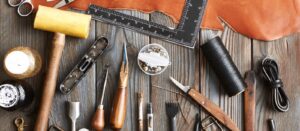
How to Soften Veg Tan Leather | Benefits to Veg-Tanned Leather?
How to Soften / Smooth Vegetable Tanned Leather
How to Soften Veg Tan Leather and make it beautiful and smooth; When it comes to wallets, belts, and other leather items, the advantages of vegetable-tanned leather include exceptional durability, affordability, and the possibility to dye in colours that match your wardrobe.
The only issue is that veg-tan leather is stiff and difficult to deal with at first, making softening it difficult. There are several methods for easily softening veg tan leather, and comprehending them doesn’t take much knowledge.
What Is the Appeal of Veg Tan Leather?
Veg tan leather has a number of other advantages, including the capacity to be readily and swiftly shaped into a variety of shapes. It not only retains its shape much better than other varieties of leather, but it also dries quickly when wet.
In practice, this means that you can use water to control wrinkles and folds in leather. When you do this, the item’s appearance and feel will not be harmed; rather, they will remain unchanged.
While some leathers become sticky with age, veg tan leather does not. In fact, veg tan leather develops a shininess over time that some people believe looks better than brand-new veg tan leather.
People enjoy this sort of leather because it can be dyed to a specific colour, thus you can always match a veg tan leather item to another item if you like. And, as the stem matures, the natural sheen varies due to the oils in your skin, making it really one-of-a-kind.
What Is the Best Way to Soften Veg Tan Leather?
The first step in softening veg-tan leather is to ensure that your hands are as clean and dry as possible. Please ensure that the location is well-ventilated and that newspapers or plastic are placed beneath the item to prevent anything from spilling onto something it shouldn’t.
If you see dirt on the leather, clean it out thoroughly before you begin working. This is significant because if the dirt is not removed at this time, it may be pushed further into the object later in the process.
Most individuals will dye their leather before softening it, not only to allow the dye colour to stick to the leather better at this point but also because coloured leather is easier to soften than undyed leather.
Choose your dye carefully, and keep in mind that mink oil dyes, while beautiful, are typically very black. If you want a particularly dark hue for your veg tan leather, avoid using this type of dye.
When applying the dye, paint it on in 1/4-inch increments and continue to apply layers until the colour is no longer soaking into the leather. Wipe away the excess dye using a paper towel and continue wiping until no more dye comes off; then, set the object aside to dry for a few minutes.
If you are unhappy with the colour, you may add more dye to the item, and once it has reached the desired hue, it is time to begin applying oil to soften the leather.
Which Kind of Oil Should You Use?
To soften your veg tan leather, you can use a variety of oils. Most people advocate mink oil, natural olive oil, or neatsfoot oil, all of which are inexpensive and simple to apply.
Wear gloves when applying the oil, and brush the oil across the full surface of the leather until the oil has penetrated through to the other side. Ensure that the oil has completely penetrated the leather.
Allow the item to sit for 15-20 minutes after applying the oil to fully absorb it into the leather. Darker hues may have a longer wait time than 15-20 minutes, so keep an eye on it to determine how long to let the oil absorb.
Examine the leather after about 20 minutes and, if necessary, reapply for extra oil and wait another 15-20 minutes. When you’re satisfied with how the leather item looks, proceed to the following stage. The trick is to ensure that you’ve applied enough oil to penetrate the leather item. Adding extra oil will darken it.
The Following Step
Following this, you should allow the leather item to dry completely, which normally takes at least eight hours. To be on the safe side, many individuals choose to let the item dry overnight.
When it’s entirely dry, use your fingertips to apply a very tiny coating of lotion or soap to the leather in a circular motion.
Do this for no more than 10 minutes. After cleaning away all excess oil, let the leather item dry overnight. Allow at least 2-3 hours between coats of oil to dry. Overnight is preferable because it guarantees that the oil is entirely dry.
Conclusion
Remember that you can soften your veg tan leather with wax or glycerin, as well as the oils suggested above.
Oils leave a wonderful gloss on the leather and usually darken the colour slightly, making it more malleable. Impurities in the leather fibres will be removed by glycerin.
The post How to Soften Veg Tan Leather appeared first on https://chucksleatherworks.com/
The post How to Soften Veg Tan Leather | Benefits to Veg-Tanned Leather? appeared first on https://icepodder.com
The post How to Soften Veg Tan Leather | Benefits to Veg-Tanned Leather? appeared first on https://wookicentral.com
The post How to Soften Veg Tan Leather | Benefits to Veg-Tanned Leather? appeared first on https://gqcentral.co.uk
